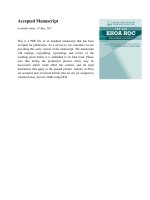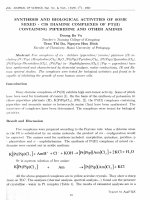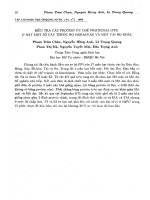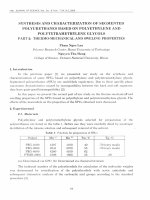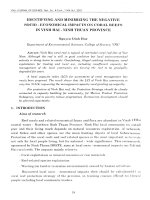DSpace at VNU: Building and Evaluating Vietnamese Language Models
Bạn đang xem bản rút gọn của tài liệu. Xem và tải ngay bản đầy đủ của tài liệu tại đây (233.39 KB, 13 trang )
VNU Jounal of science, Mathermatics - Physics 27 (2011) 134-146
Building and Evaluating Vietnamese Language Models
Cao Van Viet, Do Ngoc Quynh, Le Anh Cuong*
University of Engineering and Technology, Vietnam National University, Ha Noi (VNU)
E3-144, Xuân Thuy, Cau Giay, Ha Noi
Received 05 September 2011, received in revised from 28 October 2011
Abstract: A language model assigns a probability to a sequence of words. It is useful for many
Natural Language Processing (NLP) tasks such as machine translation, spelling, speech
recognition, optical character recognition, parsing, and information retrieval. For Vietnamese,
although several studies have used language models in some NLP systems, there is no independent
study of language modeling for Vietnamese on both experimental and theoretical aspects. In this
paper we will experimently investigate various Language Models (LMs) for Vietnamese, which
are based on different smoothing techniques, including Laplace, Witten-Bell, Good-Turing,
Interpolation Kneser-Ney, and Back-off Kneser-Ney. These models will be experimental
evaluated through a large corpus of texts. For evaluating these language models through an
application we will build a statistical machine translation system translating from English to
Vietnamese. In the experiment we use about 255 Mb of texts for building language models, and
use more than 60,000 parallel sentence pairs of English-Vietnamese for building the machine
translation system. b
Key words: Vietnamese Language Models; N-gram; Smoothing techniques in language models;
Language models and statistical machine translation
1. Introduction∗
A Language Model (LM) is a probability distribution over word senquences. It allows us to
estimate the probability of a sequence of m elements in a language, denoted by
, where
each wi is usually a word in the language. It means that from a LM we can predict the ability of
appearing a sequence of words. By using the Bayesian inference, we easily obtain the following
formula:
P(w ,1w ,2…w ,m) = P(w ,1) * P(w ,2|w ,1) * P(w ,3|w ,1w ,2) *…* P(w ,m|w1… w ,m-1) (1)
_______
∗
Corresponding author: Tel:. (+84) 912 151 220
134
L.A.Cuong et at. / VNU Jounal of Science, Mathermatics - Physics 27 (2011) 134-146
135
According to the formula (1), the probability of a sequence of words can be computed through the
conditional probability of appearing a word given previous words (note that P(w1)=P(w ,1|start)
where start is the symbol standing for the beginning of a sentence). In practice, based on the Markov
Assumption we usually compute the probability of a word using at most N previous words (N is
usually equal 0,1, 2, or 3.
From that interpretation, we can use N-gram model instead of Language Model (note that N is
counted including the target word). Each a sequence of N words is considered as an N-gram. Some
popular N-gram types are illustrated through the following example.
Suppose that we need to compute the probability p = P(sách | tôi đã từng đọc quyển):
- 1-gram (unigram) computes the probability of a word without considering any previous word. It
means that: p = P(sách)
- 2-gram (bigram) computes the probability of a word, conditioned on its one previous word. It
means that: p = P(sách|đọc)
- 3-gram (trigram) computes the probability of a word, conditioned on its two previous words. It
means that: p = P(sách|đọc quyển)
Many NLP problems using language models can be formulated in the framework of the Noise
Channel Model. In this view, suppose that we are having an information quantity, and transfer it
through a noise channel. Then, because of the noise environment of the channel, when receiving the
information again we may lost some information. The task here is how to recover the original
information. For example, in speech recognition problem we receive a sentence which has been
transferred through a speech source. In this case, because we may lost some information depending on
the speaker, we usually image several words for each sound (of a word). Consequently we may obtain
many potential sentences. Then, using a statistical language model we will choose the sentence which
has the highest probability.
Therefore, LMs can be applied in such problems which use them in the framework of noise
channel model, such as speech recognition [11, 26], optical character recognition [1, 22], spelling [9].
Some other applications use LMs as criteria to represent knowledge resources. For example, in
information retrieval, some studies used language model for representing questions and documents, as
in [12, 25]. Moreover, the techniques used for estimating N-gram and the N-gram itself are widely
used in many other NLP problems such as part-of-speech tagging, syntactic parsing, text
summarization, collocation extraction, etc. In addition, one of the most important application of LMs
is statistical machine translation (SMT). It is used for translating fluently. It is also useful for lexical
disambiguation.
As well known, Maximum Likelihood Estimation (MLE) is the popular method for estimating Ngram probabilities. However, it usually faces to the zero division problem. Therefore, some smoothing
techniques for LMs are developed to resolve this problem. There are three common strategies of
136
L.A.Cuong et at. / VNU Jounal of Science, Mathermatics - Physics 27 (2011) 134-146
smoothing techniques, including Discounting, Back-off, and Interpolation. The popular methods of
discounting include Laplace, Good-Turing, and Witten-Bell. The effective methods for interpolation
and back-off are Interpolation Kneser-Ney and Back-off Kneser-Ney presented in [15]. Note that these
techniques have been being applied widely for building LMs and used for many NLP systems.
Some recent studies have focused on the complex structures for building new LMs, for example a
syntax-based LM is used for speech recognition [8], and for machine translation [5]. In other studies,
they used a very large number of texts (usually use web-based) for building LMs to improve the task
of word sense disambiguation, statistical machine translation [3, 2].
For Vietnamese, there are some studies have tried to apply N-gram for some ambiguity NLP
problems, for example the authors in [24] used N-gram for word segmentation, the authors in [19]
used N-gram for speech recognition. However, these studies have not worked on evaluating and
comparing different LMs. We cannot intuitively separate unigram, bigram, trigram, as well as cannot
image how a word depends on previous words for Vietnamese. Therefore, in this paper we focus on
experimently investigating these aspects of LMs for Vietnamese, specially on both syllabi and words.
In addition, to apply LMs for Vietnamese text processing, we will investigate different LMs when
applying them for an English-Vietnamese SMT system to find out the most appropriate LM for this
application.
The rest of paper is organized as follows: section 2 presents different N-gram models based on
different smoothing techniques/methods; section 3 presents the evaluation of LMs using Perplexity
measurement; section 4 presents SMT and the role of Language Models in SMT; section 5 presents
our experiments; and section 6 is the conclusion.
2. Smoothing Techniques
To compute the probability P(w ,i|w ,i-n+1...w ,i-1) we usually use a collection of texts which are
called the training data. Using MLE we have:
P(w ,i|w ,i-n+1...w ,i-1) = Error! (2)
where C(w ,i-n+1...w ,i-1w ,i) and C(w ,i-n+1...w ,i-1) are the frequencies (or counts) of appearing w ,i-n+1
...w ,i-1w ,i and w ,i-n+1...w ,i-1 in the training data, respectively. Formula (2) gives a value for P(w ,i
|w ,i-n+1...w ,i-1), we call it the “raw probability”.
When the training data is sparse, there are many N-grams which do not appear in the training data
or appear with a few times. In this situation the “raw probability” will be not correct. For example it is
easy to meet a sentence which is correct on both grammar and semantic but its probability is equal to
zero because it contains an N-gram which does not appear in the training data. To solve the zero
division problem we use some smoothing techniques, each of them corresponds to a LM ( see [13, 18]
for more detail reference). They are categorized as follows.
L.A.Cuong et at. / VNU Jounal of Science, Mathermatics - Physics 27 (2011) 134-146
137
Discounting: discounting (lowering) some non-zero counts in order to get the probability mass that
will be assigned to the zero counts.
Back-off : we only “back-off” to a lower order N-gram if we have zero evidence for a higherorder N-gram.
Interpolation: compute the probabilities of an N-gram based on lower order N-grams. Note that we
always mix the probability estimates from all the N-gram estimators.
3. Discounting methods
We present here three popular discounting methods: Laplace (one popular method of them is the
Add-one method), Witten-Bell, and Good-Turing.
Add-one method:
This method adds 1 to each count of N-grams. Suppose that there are V words in the vocabulary,
we also need to adjust the denominator to take into account the extra V observation. Then, the
probability is estimated as:
P(w ,i|w ,i-n+1...w ,i-1) = Error!
In generalization we can use the following formula:
P(w ,1w ,2...w ,n) = Error!
The value of λ is chosen in the interval [0, 1], with some specific values:
•
λ = 0: without smoothing (MLE)
•
λ = 1: Add-one method
•
λ = Error!: Jeffreys – Perks method
Witten-Bell method:
The Witten-Bell method [27] models the probability of a previously unseen event by estimating
the probability of seeing such a new event at each point as one proceeds through the training data. In
unigram, denote T as the number of different unigram, and denote M as the total number of all
unigrams. Then, the probability of a new unigram is estimated by: Error!
Let V is the vocabulary’ size and Z is the number of unigrams which doesn’t appear in the training
data, then: Z = V – T. Then the probability of a new unigram (i.e. its count is equal 0) is estimated by:
p* = Error!
And the probability of an unigram which is not the zero-count is estimated by:
P(w) = Error!
where c(w) is the count of w.
When considering the N-grams with N>1, if we replace M by C(w ,i-n+1...w ,i-1) then the probability
of w ,i-n+1...w ,i-1w ,i (here C(w ,i-n+1...w ,i-1w ,i) = 0) is estimated by:
138
L.A.Cuong et at. / VNU Jounal of Science, Mathermatics - Physics 27 (2011) 134-146
P(w ,i|w ,i-n+1...w ,i-1) = Error!
In the case C(w ,i-n+1...w ,i-1w ,i) > 0, we have:
P(w ,i|w ,i-n+1...w ,i-1) = Error!
Good – Turing method:
Denote Nc as the number of N-grams which appear c times. Good-Turing method will replace the
count c by c* by the formula: c* = (c+1) * Error!
Then, the probability of an N-gram with its count c is computed by:
P(w) = Error! where N = Error!NError!c = Error!NError!c* = Error! NError!(c+1)
In the practice, we do not replace all c by c*. We usually choose a threshold k, and only replace c
by c* if c is lower than k.
3.1 Back-off methods
In the discounting methods such as Add-one or Witten-Bell, if the phrase w ,i-n+1...w ,i-1w ,i does not
appear in the training data, and the phrase w ,i-n+1...w ,i-1 also does not appear, then the probability of
w ,i-n+1...w ,i-1w ,i is still equal zero. The back-off method in [14] avoids this drawback by estimating
the probabilities of a new N-gram based on lower order N-grams, as the following formula.
P ,B(w ,i|w ,i-n+1...w ,i-1) =
For bigram, we have:
P ,B(w ,i|w ,i-1) =
Similarly for trigram:
P ,B(w ,i|w ,i-2w ,i-1) =
Here, we can choose constant values for α ,1 and α ,2. In another way, we can design α ,1 and α ,2 as
functions of N-gram as: α ,1 = α ,1(w ,i-1w ,i) and α ,2 = α ,2(w ,i-1w ,i).
However it is easy to see that in these above formulas the sum of all probabilities (of all N-grams)
is greater than 1. To solve this problem, we usually combine discounting techniques into these
formulas. Therefore, in practice, we have the following formulas for the back-off method:
P(w ,i|w ,i-2w ,i-1) =
where P’ is the probability of the N-gram when using an discounting method.
L.A.Cuong et at. / VNU Jounal of Science, Mathermatics - Physics 27 (2011) 134-146
139
3.2 Interpolation methods
This approach has the same principle with the back-off approach that uses lower order N-grams to
compute the higher order N-grams. However, it is different from back-off methods in the point of
view: it always use lower order N-grams without considering that the count of the target N-gram is
equal zero or not. We have the formula as follows.
P ,I(w ,i|w ,i-n+1...w ,i-1) = λP(w ,i|w ,i-n+1...w ,i-1) + (1-λ)P ,I(w ,i|w ,i-n+2...w ,i-1)
Apply for bigram and trigram we have:
P ,I(w ,i|w ,i-1) = λP(w ,i|w ,i-1) + (1-λ)P(w ,i)
P(w ,i|w ,i-2w ,i-1) = λ ,1P(w ,i|w ,i-2w ,i-1) + λ ,2P(w ,i|w ,i-1) + λ ,3P(w ,i) với Σ, ,i λ ,i = 1
In the above formulas, the weights can be estimated using the Expectation Maximization (EM)
algorithm or by the Powell method presented in (Chen and Goodman 1996).
3.3 Kneser-Ney’s smoothing
The Kneser-Ney algorithms [15] have been developed based on the back-off and interpolation
approaches. Note that Kneser-Ney algorithms do not use discounting techniques. They are shown as
the following (see more detail in [6]).
The formula for Back-off Kneser-Ney is presented as follows.
P ,BKN(w ,i|w ,i-n+1..w ,i-1) =
where:
P ,BKN(w ,i) = Error! where N(vw) is the number of different words v appearing at right ahead of w
in the training data.
α(w ,i-n+1..w ,i-1) = Error!
The formula for Interpolation Kneser-Ney is presented as follows.
P ,IKN(w ,i|w ,i-n+1..w ,i-1) = Error! + λ(wError!..wError!)PError!(wError!|wError!..wError!)
where:
λ(w ,i-n+1..w ,i-1) =
Error! where N(wError!..wError!v) is the number of different word v
appearing right after the phrase w ,i-n+1..w ,i in the training data.
P ,IKN(w ,i) = Error! + λ Error! where N(vw) is the number of different words v appearing at
right ahead of w in the training data.
λ = Error!
140
L.A.Cuong et at. / VNU Jounal of Science, Mathermatics - Physics 27 (2011) 134-146
In the both back-off and interpolation models, D is chosen as:
where N1 and N2 are
the number of N-grams which appear 1 and 2 times respectively.
4. Evaluating language model by Perplexity
There are usually two approaches for evaluating LMs. The first approach depends on only the LM
itself, using a test corpus, called intrinsic evaluation. The second approach is based on the application
of the LM, in which the best model is the model which brings the best result for the application, it is
called extrinsic evaluation.
This section presents the first approach based on Perplexity measurement. The next section will
present the second approach when applying for a SMT system.
Perplexity of a probability distribution p is defined as:
where H(p) is the entropy of p.
Suppose that the test corpus is considered as a sequence of words, denoted by W= w1…wN, then
according to [13] we have the approximation of H(W) as follows.
A LM is a probability distribution over entire sentences. The Perplexity of the language model P
on W is computed by:
Note that given two probabilistic models, the better model is the one that has a tighter fit to the test
data, or predicts the details of the test data better. Here, it means that the better model gives higher
probability (i.e. lower Perplexity) to the test data.
5. Evaluating language models through a SMT system
The problem of Machine Translation (MT) is how to automatically translate texts from one
language to another language. MT has a long history and there are many studies focusing on this
problem with various discovered techniques. The approaches in MT include direct, transfer (or rulebased), example-based, and recently statistical MT (SMT) has been becoming the most effective
approach.
L.A.Cuong et at. / VNU Jounal of Science, Mathermatics - Physics 27 (2011) 134-146
141
SMT was firstly mentioned in the paper [4]. The beginning systems are word-based SMT. The
next development is phrase-based SMT [16], which has shown a very good quality in comparison with
the conventional approaches. SMT has the advantage that it doesn’t depend on linguistic aspects and
uses only a parallel corpus for training the system (note that recent studies concentrates on integrating
linguistic knowledge into SMT). In the following we will investigate the basic SMT system and the
role of LMs to it.
Suppose that we want to translate an English sentence (denoted by E) to Vietnamese. The SMT
approach assumes that we are having all Vietnamese sentences, and V* is the translation sentence in
Vietnamese if it satisfies:
(Note that in practice, we will determine V* among a finite set of sentences which can be potential
translation of E).
According to Bayesian inference we have:
Because P(E) is fixed for all V so we have:
We can see that the problem now is how to estimate P(E|V)*P(V), where P(E|V) represents for the
translation between V and E, and P(V) (which is computed by a LM) represents for how the translation
is natural, smooth in the target language. Another effect of P(V) is that it will remove some wrong
translation elements which may be selected in the process of determining P(E|V).
Therefore, LMs play an important role for SMT. In the experiment we will investigate different
LMs in a English to Vietnamese SMT system. We will use BLEU score to evaluate which LM is most
effective for this machine translation system.
6. Experiment
On the work of conducting necessary experiments, we firstly collect raw data from Internet, and
then standardize the texts. We also carry out the task of word segmentation for building LMs at word
level. Different LMs will be built based on different smoothing methods: Laplace, Witten-Bell, GoodTuring, Back-off Kneser-Ney, and Interpolation Kneser-Ney. For this work we use the open toolkit
SRILM [23].
To build an English-Vietnamese machine translation system we use the open toolkit MOSES [17].
Note that the LMs obtained from the experiment above will be applied in this SMT system.
142
L.A.Cuong et at. / VNU Jounal of Science, Mathermatics - Physics 27 (2011) 134-146
Data preparation
The data used in LM construction are collected from the news sites (dantri.com.vn, vnexpress.net,
vietnamnet.vn). These HTML pages are then processed through some tools for tokenizing and
removing noise texts. Finally we acquire a corpus of about 255 Mb (including nearly 47 millions of
syllabi). We also use a word segmentation tool on this data and obtain about 42 millions of words.
Table 1 shows the statistics of unigrams, bigrams, and trigrams on both syllabi and words. Note that
this data is used for building language models, in which we use 210 Mb for training and 45 Mb for
testing.
Kind of unit
Number
Number of
Number of
Number of
Of units
different
different
different
Unigram
Bigram
Trigram
Syllabus
46,657,168
6,898
1,694,897
11,791,572
Word
41,469,980
35,884
3,573,493
16,169,361
Table 1: Statistics of unigrams, bigrams, and trigrams
To prepare data for SMT, we use about 60 thousands of parallel sentence pairs (from a national
project in 2008 aiming to construct labeled corpora for natural language processing). From this corpus,
55 thousands pairs are used for training, and 5 thousands pairs for testing.
Intrinsic evaluation of N-gram models
The smoothing methods used for building LMs are Laplace (includes Jeffreys – Perks and addone), Witten-Bell, Good-Turing, Knerser-Ney interpolation, and Knerse-Ney back-off. Table 2 shows
the Perplexity for these models on the test data at syllabus level. Table 2 shows the similar experiment
but at word level.
It is worth to repeat that Perplexity relates to the probability of appearing a word given some
previous words. For example in the Table 2, the Good-Turing model gives Perplexity a value of
64.046 on 3-gram means that there are about 64 values (or options) for a word if given the two
previous words. Therefore, a LM is considered better than the other if it has lower Perplexity on the
test data.
N-gram
Perplexity values
1-gram
Add-0.5
Jeffreys Perks
658.177
2-gram
130.045
Add-one
Witten
Bell
Good
Turing
658.168
658.291
658.188
Interpolatio
n KneserNey
658.23
142.249
116.067
115.422
114.359
Kneser-Ney
Back-off
658.23
114.631
143
L.A.Cuong et at. / VNU Jounal of Science, Mathermatics - Physics 27 (2011) 134-146
3-gram
227.592
325.746
64.277
64.046
60.876
61.591
Truy hồi
KneserNey
924,679
Table 2: Perplexity for syllabus
N-gram
Perplexity values
1-gram
Add-0.5
Jeffreys Perks
924,571
Add-one
Witten
Bell
Good
Turing
924,543
924,975
924,639
Nội suy
KneserNey
924,679
2-gram
348,715
443,225
188,961
187,51
183,475
183,853
3-gram
1035,8
1573,69
125,786
123,856
115,884
117,799
Table 3: Perplexity for words
From Table 2 and Table 3 we can infer the two important remarks as follows.
- Among discounting methods, Good-Turing gives best results (i.e. lowest perplexity) on all
unigram, bigram, and trigram. In there, Good-Turing and Witten-Bell have similar results. We can
also see that the higher N (of N-gram) is the better Good-Turing and Witten-Bell are, in comparison
with Laplace methods. In practice, people simply use Laplace methods, and in such cases they must be
noted that Jeffreys-Perks method (i.e. the Add-half method) is much better than Add-one method.
- Interpolation Kneser-Ney is better than Back-off Kneser-Ney and both of them give better
results (i.e. lower perplexity) in comparison with Good-Turing and Witten-Bell. We can also see that
the quality distance between Kneser-Ney methods and Good-Turing/Witten-Bell will be bigger if we
increase N (of N-gram).
Moreover, we can see that the best Perplexity scores for 3-gram are about 61 (computing on
syllabi) and 116 (computing on words). These values are still high, therefore in the NLP problems
which use Vietnamese language model, if we can use N-gram with the higher order then we can obtain
better results.
Extrinsic valuation of N-gram models using SMT
In this work we will use the LMs obtained in section 5.2 and integrate them into a SMT system
(using MOSES). Because SMT systems treat words as the basic elements so in this work we just use
the word-based LMs. Table 4 gives us the BLEU scores [20] of the SMT system on different LMs.
144
L.A.Cuong et at. / VNU Jounal of Science, Mathermatics - Physics 27 (2011) 134-146
N-gram
BLEU scores
Add-0.5
Jeffreys -
Add-One
Perks
Witten
Good
Kneser-Ney
Kneser-Ney
Bell
Turing
interpolation
Back-off
1-gram
16.53
16.53
16.49
16.52
16.51
16.51
2-gram
20.51
19.52
22.42
22.62
22.56
22.64
3-gram
16.30
15.67
23.64
23.89
23.91
23.83
Table 4: BLEU scores on different N-gram models
From Table 4 we can infer the some important remarks as follows.
- Among discounting methods, Good-Turing and Witten-Bell have similar results and they are
much better in comparison with Laplace methods, for all unigram, bigram, and trigram. It is
interesting that this correlation is corresponding to the remarks presented in section 5.2.
- From the BLEU scores, we can not see the significant difference between Good-Turing,
Interpolation Kneser-Ney, and Back-off Kneser-Ney. However, it is worth to emphasize that the best
BLEU score is obtained at using the 3-gram model with Knerser-Ney interpolation. It is also
corresponding to the intrinsic evaluation of LMs in section 5.2.
These experimental results and the above remarks allow us to draw a conclusion that Good-Turing
is a simple method but good enough for applying to a language model in a SMT system. Beside that if
the translation quality is important, we should use Interpolation Kneser-Ney on high order N-gram
models.
7. Conclusion
In this paper we have investigated in detail Vietnamese LMs on both experimental and theoretical
aspects. The experiments allow us to intuitively compare different LMs based on different smoothing
methods. The obtained results when evaluating LMs independently or in applying for a SMT system
has shown that Witten-Bell, Good-Turing, Interpolation Kneser-Ney, and Back-off Kneser-Ney are
much better than Laplace methods. Among them, Interpolation Kneser-Ney is the best method on the
both tests. The experiment also indicates that Good-Turing is a simple method but good enough, so it
should be recommended to related NLP applications.
For further study, this work will be extended with higher order N-grams and larger data to get
more evidences supporting for the conclusion. However in such the case, the problem becomes more
complex in the aspects of computational time and storing memory. We will focus on this problem in
the next study.
L.A.Cuong et at. / VNU Jounal of Science, Mathermatics - Physics 27 (2011) 134-146
145
References
[1] Adrian David Cheok, Zhang Jian, Eng Siong Chng (2008) . Efficient mobile phone Chinese optical character
recognition systems by use of heuristic fuzzy rules and bigram Markov language models. Journal of Applied
Soft Computing . Volumn 8(2), pp. 1005 – 1017.
[2] S. Bergsma, Dekang Lin, and Randy Goebel.( 2009). Web-scale N-gram models for lexical disambiguation. In
IJCAI. Pp. 1507-1512.
[3] T. Brants, Ashok C. Popat, Peng Xu, Franz J. Och, and Jeffrey Dean. (2007). Large language models in
machine translation. In EMNLP. pp. 858–867.
[4] P. Brown, S. Della Pietra, V. Della Pietra, and R. Mercer (1993). The mathematics of statistical machine
translation: parameter estimation. Computational Linguistics, 19(2), pp. 263-311.
[5] E. Charniak, Kevin Knight, and Kenji Yamada. (2003) Syntax-based Language Models for Statistical Machine
Translation. In Proceedings of Machine Translation Summit IX, pp. 40-46.
[6] Chen, Stanley F., and Joshua Goodman. (1996). An empirical study of smoothing techniques for language
modeling. In ACL 34, pp. 3-18.
[7] S. F. Chen and J. Goodman, ``An Empirical Study of Smoothing Techniques for Language Modeling,'' TR-1098, Computer Science Group, Harvard Univ., 1998.
[8] M. Collins , Brian Roark , Murat Saraclar. (2005) Discriminative syntactic language modeling for speech
recognition, Proceedings of ACL. pp. 503-514.
[9] Herman Stehouwer, Menno van Zaanen. (2009). Language models for contextual error detection and correction.
Proceedings of the EACL 2009 Workshop on Computational Linguistic Aspects of Grammatical Inference. pp.
41-48.
[10] Jay M. Ponte, Bruce W. Croft. (1998) A Language Modeling Approach to Information Retrieval. In Research
and Development in Information Retrieval. pp. 275-281.
[11] F. Jelinek, B. Merialdo, S. Roukos, and M. Strauss. (1991), A Dynamic Language Model for Speech
Recognition. Human Language Technology Conference , Proceedings of the workshop on Speech and Natural
Language table of contents. pp. 293 – 295.
[12] Jin R., Hauptmann A.G. and Zhai C.(2002) Title Language Model for Information Retrieval. In Proceedings of
the ACM SIGIR Conference on Research and Development in Information Retrieval. pp. 42-48.
[13] D. Jurafsky, James H. Martin. (2000) “Speech and Language Processing: An Introduction to Natural Language
Processing, Computational Linguistics and Speech Recognition”. Pages 189-232.
[14] S.M. Katz. (1987) “Estimation of probabilities from sparse data for the language model component of a speech
recognizer” , IEEE Trans. on Acoustics, Speech and. Signal Proc. ASSP 35(3), pp. 400-401.
[15] Kneser Reinhard, and Hermann Ney. (1995) Improved backing-off for m-gram language modeling. In
Proceedings of ICASSP-95, vol. 1, pp. 181–184.
[16] P. Koehn, F.J. Och, and D. Marcu (2003). Statistical phrase based translation. In Proceedings of the Joint
Conference on Human Language Technologies and the Annual Meeting of the North American Chapter of the
Association of Computational Linguistics (HLT/NAACL). pp. 127-133.
[17] P. Koehn, H. Hoang, A. Birch, C. Callison-Burch, M. Federico, N. Bertoldi, B. Cowan, W. Shen, C. Moran, R.
Zens, C. Dyer, O. Bojar, A. Constantin, and E. Herbst. (2007) Moses: Open source toolkit for statistical
machine translation. In ACL. Pages 177-180.
[18] C. Manning and Hinrich Schutze,(1999) Foundations of Statistical Natural Language Processing, MIT Press.
Cambridge, May 1999.
[19] H. Q. Nguyen, Pascal NOCERA, Eric CASTELLI, TRINH Van Loan., "A novel approach in continuous speech
recognition for Vietnamese, an isolating tonal language," in Proc. Interspeech'08, Brisbane, Australia, 2008, pp.
1149-1152.
146
L.A.Cuong et at. / VNU Jounal of Science, Mathermatics - Physics 27 (2011) 134-146
[20] Papineni, K., Roukos, S., Ward, T., and Zhu, W. J. (2002). "BLEU: a method for automatic evaluation of
machine translation" in ACL-2002: 40th Annual meeting of the Association for Computational Linguistics. pp.
311-318.
[21] Petrov, Slav, Aria Haghighi, and Dan Klein. (2008) Coarse-to-fine syntactic machine translation using language
projections. In Proceedings of ACL-08. pp.108–116.
[22] Suryaprakash Kompalli, Srirangaraj Setlur, Venu Govindaraj. Devanagari (2009) OCR using a recognition
driven segmentation framework and stochastic language models. International Journal on Document Analysis
and Recognition. Volume 12 (2) Pages: 123-138
[23] A. Stolcke. (2002) SRILM – an extensible language modeling toolkit . In Proceedings of ICSLP, Vol. 2, pp.
901-904.
[24] O. Tran, A.C. Le, Thuy Ha, 2008. Improving Vietnamese Word Segmentation by Using Multiple Knowledge
Resources. Workshop on Emirical Methods for Asian Languages Processing (EMALP), PRICAI.
[25] Zhang Jun-lin , Sun Le , Qu Wei-min , Sun Yu-fang, (2004) A trigger language model-based IR system,
Proceedings of the 20th international conference on Computational Linguistics. pp. 680-686.
[26] D. Vergyri, A. Stolcke, and G. Tur, (2009) "Exploiting user feedback for language model adaptation in meeting
recognition," in Proc. IEEE ICASSP, (Taipei), pp. 4737-4740.
[27] Witten Ian H., and Timothy C. Bell. (1991) The zero-frequency problem: Estimating the probabilities of novel
events in adaptive text compression. IEEE Transactions on Information Theory, 37: 1085-1094.




